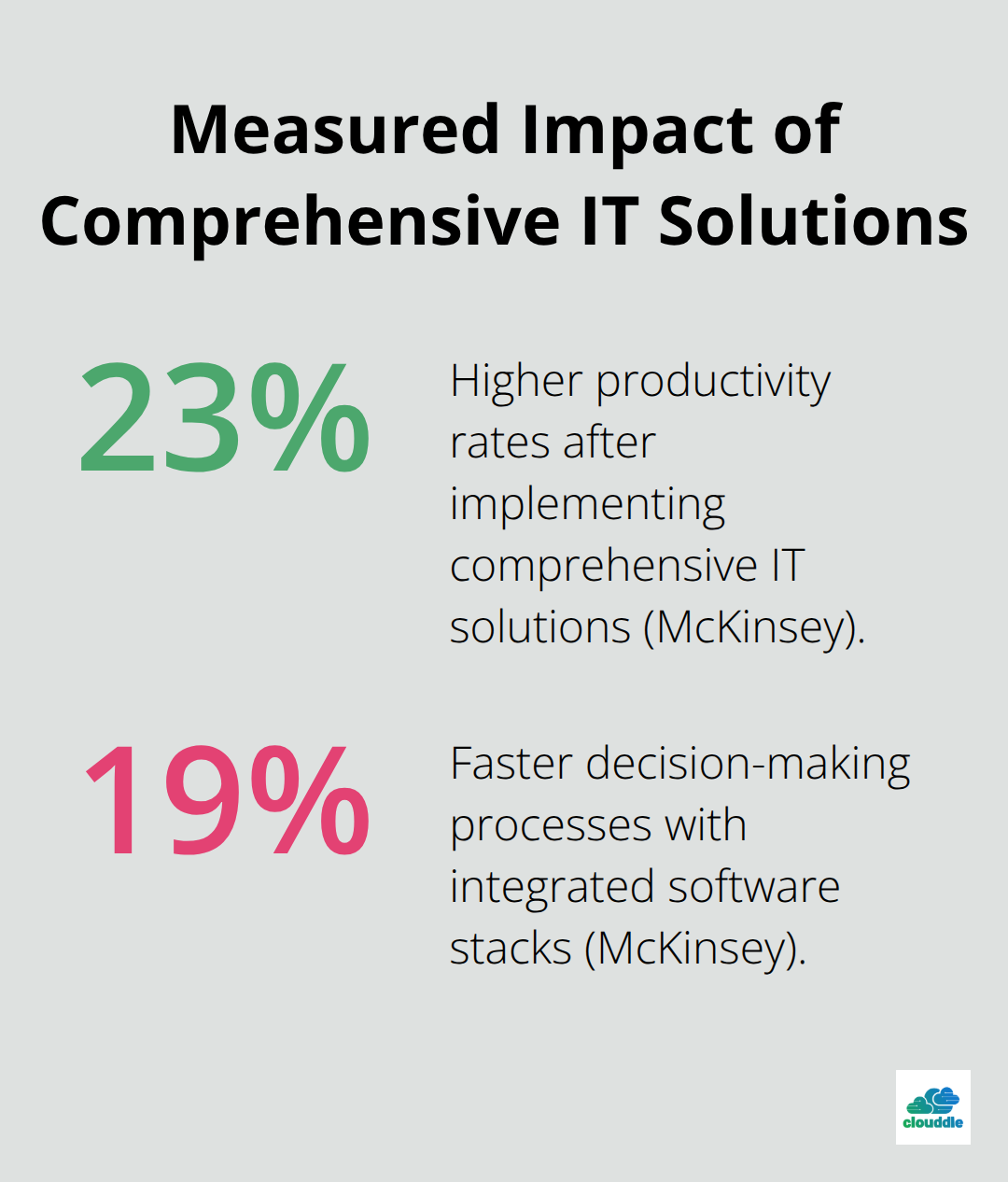Modern businesses face mounting pressure to optimize operations while staying competitive. The right IT software solutions for business can transform how companies operate, from automating routine tasks to providing actionable insights from data.
At Clouddle, we’ve seen firsthand how strategic software implementation drives measurable growth. Companies that invest in comprehensive IT solutions report 23% higher productivity rates and 19% faster decision-making processes according to recent McKinsey research.

Types of IT Software Solutions for Business
Enterprise Resource Planning Systems Form Business Infrastructure
Enterprise Resource Planning systems serve as the foundation for modern business operations. Companies that deploy ERP systems benefit from free flow of communication between business areas, a single source of information, and accurate, real-time data reporting. SAP and Oracle control significant market share, but smaller businesses often succeed with cloud-based alternatives like NetSuite or Microsoft Dynamics 365.
These systems integrate finance, inventory, human resources, and supply chain management into one unified platform. Data silos cost businesses significant productivity losses, making ERP integration essential for operational efficiency.
Customer Relationship Management Software Drives Revenue Growth
CRM software commands the largest enterprise software segment. While CRM systems focus on storing customer information, sales intelligence uncovers valuable prospect data, and revenue intelligence transforms business operations. Salesforce leads market share, but businesses must evaluate alternatives based on specific requirements. HubSpot excels for inbound marketing strategies, while Pipedrive works better for sales-focused teams.
Companies that implement comprehensive CRM systems report higher revenue per salesperson and faster deal closure rates. Success depends on choosing platforms that integrate with existing tools and provide actionable customer insights rather than simple contact storage.
Project Management Platforms Accelerate Team Performance
ClickUp achieved high user satisfaction through centralized productivity management with customizable dashboards. Microsoft Project remains the enterprise standard for complex projects, while Asana and Monday.com serve growing teams more effectively.
The most effective project management software combines task tracking, resource allocation, and real-time collaboration features. Teams that use dedicated project management platforms complete projects faster and stay within budget more often than those relying on email and spreadsheets.

These three software categories work together to create comprehensive business transformation, but selecting the right combination requires understanding how each solution drives specific growth outcomes.
How IT Software Solutions Drive Business Growth
Automated Systems Eliminate Manual Bottlenecks
Software automation removes repetitive tasks that drain employee productivity. Companies using Enterprise Resource Planning systems report higher productivity rates according to McKinsey research. Automated invoice processing cuts processing time from hours to minutes, while inventory management systems prevent stockouts and overstock situations.
Rippling achieves 90% user satisfaction through its unified platform that handles HR, IT, payroll, and spend management. Manual data entry errors cost businesses an average of $3.1 million annually (IBM research), which makes automation essential for both accuracy and operational efficiency.
Real-Time Data Analytics Accelerate Decision Speed
Microsoft SQL Server delivers superior data analysis capabilities with top-tier performance and security features, earning 89% user satisfaction. Companies that implement comprehensive business intelligence tools make decisions 19% faster than competitors who rely on spreadsheet analysis.
Real-time dashboards provide immediate visibility into key performance indicators, while predictive analytics identify trends before they impact revenue. Organizations that use advanced analytics report significant profit improvements according to research.
Customer Experience Platforms Boost Revenue Performance
CRM systems with integrated analytics significantly boost customer retention rates. UniOne achieved 89% satisfaction through improved email workflows and user engagement tracking capabilities. Companies that implement customer experience platforms see 15% revenue increases within the first year of deployment.
Automated customer service responses reduce support ticket resolution time by 67%, while personalized marketing campaigns generate 42% higher conversion rates than generic approaches. These performance improvements create the foundation for selecting software solutions that align with specific business objectives and growth targets.
Choosing the Right IT Software for Your Business
Start with Process Analysis Before Feature Comparison
Poor data quality costs organizations at least $12.9 million a year on average according to Gartner research. This makes systematic evaluation essential for success. Start with workflow analysis rather than feature comparisons. Map your current processes and identify where employees spend excessive time on manual tasks.
Companies that document their pain points before vendor meetings achieve better software ROI than those who jump directly into product demonstrations. This approach prevents costly mistakes and focuses attention on solutions that address real operational challenges.
Prioritize Integration Over Standalone Features
Software that cannot communicate with existing systems creates new data silos instead of solving operational problems. Microsoft Azure Monitor achieves high satisfaction through proactive identification of performance issues across integrated applications.
Focus on integration capabilities when you evaluate options. Systems that work together amplify productivity gains, while isolated tools often create more work for your team. Test API connections and data flow between platforms before you make final decisions.

Calculate Total Investment Beyond License Costs
Calculate total cost of ownership including training, data migration, and ongoing support rather than just licensing fees. Nucleus Research found that businesses achieve significant return for every dollar spent on ERP systems, but only when implementation costs stay within projected budgets.
Hidden costs often exceed initial estimates (training can consume significant portions of total project budgets). Factor in employee time for system adoption, potential productivity dips during transition periods, and ongoing maintenance requirements when you compare vendor proposals.
Verify Performance Claims Through References
Demand vendor references from companies with similar size and industry requirements. Verify actual performance improvements rather than accepting marketing claims. Contact reference customers directly and ask specific questions about implementation challenges, actual ROI achieved, and ongoing support quality.
Software decisions that prioritize long-term scalability over immediate cost savings consistently deliver superior business outcomes. Test systems thoroughly during trial periods and involve end users in evaluation processes to identify potential adoption barriers early.
Final Thoughts
IT software solutions for business deliver measurable results when companies implement them strategically. Organizations that invest in comprehensive ERP, CRM, and project management platforms report 23% higher productivity rates and 19% faster decision-making processes. These improvements translate directly into competitive advantages and revenue growth.
Strategic software selection requires thorough process analysis, integration planning, and total cost evaluation. Organizations that prioritize long-term scalability over immediate cost savings consistently achieve superior business outcomes. The key lies in choosing solutions that work together rather than creating new operational silos.
Success depends on partnering with experienced technology providers who understand your industry requirements. At Clouddle, we help businesses implement technology solutions that drive sustainable transformation. The next step involves conducting a comprehensive technology audit to identify gaps between current capabilities and growth objectives (this foundation enables informed decisions that accelerate business performance).


